Plugin vehicles are all the rage in the Chinese auto market, with plugins scoring 743,000 sales (in a 1.7-million-unit overall market). That’s up 29% year over year (YoY).
Looking deeper at the numbers, BEVs were up 16%, while PHEVs did even better, jumping 62% in March. Breaking down plugin sales by powertrain, BEVs had 64% of sales, below this year’s average of 67%, proving the rising popularity of plugin hybrids in this market.
The year-to-date (YTD) tally is close to 1.9 million units, with Q1 ending with 36% growth YoY.
Share-wise, March saw plugin vehicles hit 43% market share! Full electrics (BEVs) alone accounted for 28% of the country’s auto sales. This pulled the 2024 share also to 39% (26% BEV), and with rumours that April will be the first month ever to reach the 50% mark, the first half of the year should end above 40%. (And maybe above 50% by year end?)
Overall Top 10 — BYD’s War on ICE Starts
The podium was 100% plugins. Two BYDs were on top, followed by the Tesla Model Y. The best selling ICE model was the Nissan Sylphy, with close to 30,000 units sold. The Japanese model was the first of four ICE models in the top 10. Among them, the surprise was the Mercedes C-Class ending in 8th, with a little more than 20,000 sales.
Benefitting from its recent War on ICE, in the Chinese market, BYD placed five models in the overall top 10! Price cuts from the Shenzhen make are pressuring not only the ICE competition, but also the plugin adversaries….
Speaking of ICE competition, where the foreign OEMs (still) have their bread and butter volumes, it is interesting to see that, a year ago, 52% of the overall market belonged to the local OEMs, while now they have 59% of the same pie. Considering that foreign OEMs currently own just 15% of the plugin market in China, versus 41% overall, and that this market is rapidly being electrified, it is clear to see that … there will be blood.
Overall Market by Segments — BYD Wins 4 Out of 5 Categories
Looking at the several categories, the A (city cars) and D (midsize) segments continue to have 100% PEV podiums, while the C (compact) segment is the only one where ICE vehicles are still a majority. Maybe it is time for BYD to launch a competitive compact hatchback? Something like the MG4/Mulan?
Anyhow, with the exception of the C segment, where the Nissan Sylphy still soldiers on as the sole ICE category leader, BYD is ahead in every other category. The surprise comes from the second youth of the BYD Han, which, despite fierce competition, has greatly benefitted from BYD’s price cuts to return to the top of the full size category. In doing so, it beat heavyweights (in both senses of the word…) like the AITO M7 and the Li Xiang L7.
Best Selling EVs — One by One
Regarding last month’s best sellers table, the top 3 best selling models in the overall table exactly mirrored the ones in the EV table — which once again proves the merging process that we are witnessing between the two tables. Here’s more info and commentary on March’s top selling electric models:
#1 — BYD Song (BEV+PHEV)
BYD’s midsize SUV is the uncontested leader in the Chinese automotive market, and this time, the star player returned to the leadership position, surpassing its Qin Plus sibling. The midsize SUV scored 62,622 registrations, with 11,244 units belonging to the BEV version. Will the Song continue to rule in the Chinese automotive market? Well, it depends on the competition, especially the internal competition. Currently, the Song only has the recently introduced Song L as internal competition, but the upcoming Sea Lion 07 and the premium car-on-stilts Denza N7 (a car that sits somewhere between the Tesla Model Y and the Zeekr 001) are both also wanting a piece of the pie. This is probably too much competition inside BYD’s midsize SUV portfolio for the Song to continue clocking 50,000 sales/month, a necessary threshold to continue leading the cutthroat Chinese auto market, but thanks to its recent price cuts, the Song is continuing its success story.
#2 — BYD Qin Plus (BEV+PHEV)
Along with the Song, the BYD Qin has been a bread and butter model for the Chinese automaker for a long time. The midsize sedan reached 50,394 registrations in March (16,910 units belonged to the BEV version), a new record for the long-running nameplate. This allowed it to be second in the overall market, with the sedan benefitting from being the first pawn launched by BYD in its recent “War on ICE” campaign (aka price cuts). Prices now start at 80,000 CNY ($12,000) and demand is bound to stay high. Despite the strong internal competition — a new, fancier Qin L is said to be launching soon — expect BYD’s lower priced midsize sedan to continue posting strong results at the cost of the competition, EV or ICE, all while keeping its most direct competitors — the Tesla Model 3, Wuling Starlight, and GAC Aion S — at a safe distance.
#3 — Tesla Model Y
Tesla’s star model got 47,917 registrations, which allowed it to land in 3rd in the overall ranking. It seems the US crossover is at cruising speed in the Chinese market, at around 25,000–30,000 units a month, peaking at about 45,000 units in the last month of the quarter. While that doesn’t make it the best seller in the market, it allows the Model Y to keep Tesla relevant in the Chinese market, and somewhat disguises the frosty reception that the refreshed Model 3 had in this market (more on this further below).
#4 — BYD Seagull
Things continue to go well for the hatchback model, with the small EV securing another top 5 presence thanks to 27,866registrations. With part of production now being diverted to export markets, it seems demand for the little Lambo is now at cruising speed in China. The perky EV is now in top 5 territory. Even with its attention now diverted to other geographies, like Latin America and Asia-Pacific, expect the little BYD to continue being part of the BYD pack that populates the Chinese top 10. What about export prospects to Europe? There are talks that the model will be launched in Europe in the second half of the year. Of course, do not expect the low prices in Europe that the Seagull has in China. When the city EV lands, as the Dolphin Mini, European prices will be significantly higher for a number of reasons (tariffs, VAT, etc.), but I wouldn’t be surprised if it started at 17,999€ … which would still be a killer price considering the direct competition is north of 20,000€.
#5 — BYD Yuan Plus
A big beneficiary of the recent price cuts, the compact crossover returned to the top 5, thanks to 21,951 sales, keeping its most direct rival, the Aion Y (#12 with 13,000 registrations) at a safe distance. With the upcoming launch of the BYD Yuan Up, sales of the Yuan Plus could suffer. The new crossover is not that much smaller (4,32 mt vs. 4,46 mt), but it is significantly cheaper (CNY 97,000 vs. CNY 120,000) AND has a more normal design, especially inside, which might put off some but could be a plus side for others. One thing is certain: expect the Yuan Up to be another sales success for BYD. Now, about that compact hatchback…
Looking at the rest of the best seller table, the highlight also comes from BYD, with the Han flagship sedan returning to form and ending March in 6th with 20,376 sales. Just below it, the #7 Destroyer 05 breaks its personal record, registering 18,803 units, thus making it six BYDs in the top 7 positions.
On the other hand, some of BYD’s competitors (and Xiaomi’s?) have taken a beating. The AITO M7, a regular presence in the last top 5s, dropped to 8th, with 18,512 sales. Li Auto’s best performer, the L7, was just 17th, down from 8th in February, with 10,768 sales (maybe the upcoming and cheaper L6 model is casting a shadow over its bigger sibling). Meanwhile, models like the Wuling Starlight, Geely Galaxy L7, Chery Fengyun A8 PHEV (#14 in February), and Geely Panda Mini, just to name a few, vanished from the top 20. As said before, BYD’s War on ICE is also affecting the EV competition….
Why Tesla Decided Not to Refresh the Model Y in 2024
… And, speaking of EV competition, the Tesla Model 3 is surely having a nightmarish 2024 in China. In the context of a double-digit growing market and a recent refresh, it is astonishing to find that the Tesla sedan is down 25% YoY in the first quarter of the year!
In the same period, the unrefreshed Tesla Model Y was up by 6%. Sure, nothing especially great to celebrate, but at least it is not seeing demand fall off a cliff….
Even limiting the view to sedans, the Tesla Model 3 was only 5th in March, with 14,481 sales, below the all-electric Aion S (14,758) and the BEV version of the BYD Qin Plus (16,910). And March was supposed to be a peak month!
This proves that the refresh wasn’t well received by the Chinese market. True — specs and the interior had a welcome upgrade, but the exterior design change, which ditched the Porsche Panamera resemblance and embraced the 2019 Toyota Corolla look, along with the feeling that Tesla was stingy with equipment by removing stalks, parking sensors, etc., has affected the appeal of the car. And in a cutthroat market like China, those kind of missteps will hurt you.
Hence the reason why Tesla decided to postpone the refresh of its Model Y best seller. It seems they would like to have more time to figure out what went wrong with the Model 3 refresh and do it properly at a later stage.
More Top 20 Notes
Two final notes on the March top 20: The Denza D9 returned to the table, in #18, thus making it nine models out of the top 20 coming from BYD Group; while the third foreign model in the table this time wasn’t a Volkswagen, but … Buick’s Velite 6!
Yep, Buick has a successful EV in China(!), which is a compact(!!) and a station wagon(!!!), and it ended March in 20th place with 8,035 sales. Would such a model be successful in the USA? Discuss.
Outside the top 20, there are several models worth looking into, like the Cadillac Escalade sized AITO M9 registering a record 5,446 sales in March. Will AITO’s newflagship yacht be as successful in its category as the M7? Currently, the leader in the humongous SUV category is the Li Xiang L9 (18th in March with 8,595 sales). So, the distance isn’t that big….
The Zeekr 001 received a refresh recently, and it shows, with the flagship model delivering 7,503 units in March. Meanwhile, Changan’s new EV brand, called Qiyuan, had its A05 sedan reach 5,622 sales, which is a good start for Changan’s new division.
Last, but surely not least, a mention goes out to a model that only started to get delivered in April but is expected to reach 70,000 to 100,000 sales in the remaining months of 2024: the Xiaomi SU7. It is a car with unbeatable value for money. It is the size of a Tesla Model S, has air suspension, has a 0.195 drag coefficient, has 800-volt architecture, has 74 kWh LFP or 101 NMC batteries with a promise of a 150 kWh coming later on, and all of this for Tesla Model 3 prices. That is … quite an offer.
No wonder they have already locked in 70,000 orders. Not reservations, actual orders. With the electronics giant preparing the SUV version of the SU7 for 2025, and a smaller, lower-cost model is set to land in 2026, Xiaomi could be a disruptive force on the market.
The 20 Best Selling Electric Vehicles in China — January–March 2024
Looking at the 2024 ranking, there’s nothing new in the podium positions, with the the YTD ranking mimicking March’s table (BYD Song, BYD Qin Plus, Tesla Model Y).
The first position change happened just below the podium, with the BYD Seagull surpassing the AITO M7 — BYD’s baby Lambo climbed to 4th while the Huawei-backed SUV dropped to 5th.
Another BYD on the rise was the Yuan Plus, which jumped two positions to 6th, surpassing the Wuling Mini EV and its BYD Dolphin sibling.
Still on the theme of BYD models on the rise, the Han sedan was up to 9th, a four-position jump, while the Destroyer 05 did even better, shooting up 8 positions in just one month, from #19 in February to its current #11 spot. The sporty version of the Qin Plus is having its best moment ever on the market, thanks to some generous price cuts.
Regarding the lower positions on the table, the BYD takeover continued, with the Tang SUV re-joining the table at #17 and the Denza D9 MPV back on the best sellers chart at #20.
Finally, the only non-BYD model that managed to climb positions was GAC’s Aion S, that was up three spots, to #15, surpassing its Aion Y (#16) sibling.
Changes in the Overall Brand Ranking
In March, while the top three positions mirrored the 2023 full year ranking, with BYD on top, followed by Volkswagen and Toyota, the dynamics are quite different. BYD (245,000 sales) grew 35% YoY, while #2 Volkswagen (159,000 sales) was down by 2% and Toyota (113,000 sales) dropped by 8%. So, while the first is still rising fast, the other two are doing their best not lose too much ground in a fast changing market.
Geely (80,000 sales) was 4th in March, signaling a 24% growth rate. On the other hand, Honda, the 4th best selling brand in 2023, was only 8th in March, with 60,000 sales, a 26% drop YoY. The Japanese brand experienced the biggest crash within the top 20. Although, #6 Tesla wasn’t much better, having dropped 19% YoY in the same month. Although, part of Tesla’s fall can be explained by the flattening of the delivery curve — the truth is that the US automaker was down 4% in the first quarter of 2024.
Auto Brands Selling the Most Electric Vehicles in China
Looking at the auto brand ranking, there’s some major news, but not at the top. BYD (29.3%, up from 28.3%) tightened its grip on its leadership position, and there’s really no way to see this domination end anytime soon.
Things get more interesting below, though. Benefitting from Wuling’s sales bleed (5.8%, down from 6.2% — SAIC’s low cost brand is one of BYD’s War on ICE victims), Tesla (7.1%, up from 6.2% in February) is now comfortable in second place, so it could be possible for the US automaker to repeat it 2023 runner-up finish.
#3 Geely also suffered from the recent BYD price cuts, having seen its share drop from 5.2% in February to 4.7% at the end of the first quarter (it had no top 20 representatives in March), but nevertheless, it recovered one spot, rising to 4th, because AITO crashed (4.4%, down from 5.3%) — the startup brand is still too dependent on the M7’s performance. One bad month from the SUV model and things go south quite fast.
Finally, Li Auto, despite also losing share, had its losses contained (4.3% now, vs. 4.6% in February) and could look to surpass AITO in April and return to the top 5.
Auto Groups Selling the Most Electric Vehicles in China
Looking at OEMs/automotive groups/alliances, BYD Group is comfortably leading, with 31.2% share of the market, a full 2% gain in March. That increase in share was thanks to the strong result of the namesake brand, but also thanks to strong results from its premium branches, Denza, Fang Cheng Bao, and Yangwang.
Geely–Volvo is a distant runner-up, with 8.7% share, and is being threatened by SAIC (8.5%), in 3rd. Although, one should highlight that both lost some half percentage point last month, with both OEMs being badly hit by BYD’s recent price war.
Tesla (7.1%, up from 6.2%) surpassed Changan and is now 4th, but Changan itself cannot complain too much, as its new Qiyuan brand allowed it to stay afloat (6.7%, up 0.1%) in the current price war blood bath.
Have a tip for CleanTechnica? Want to advertise? Want to suggest a guest for our CleanTech Talk podcast? Contact us here.











